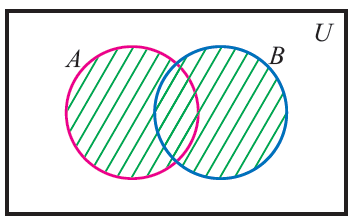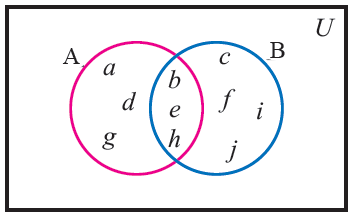VENN DIAGRAM OF A UNION B
Here we are going to see how to draw a venn diagram for A union B.
To draw venn diagram for A U B, we have to shade all the regions of A and B.
A U B

Let A and B be two sets.
Now, we can define the following new set.
A U B = {z | z ∈ A or z ∈ B }
(That is, z may be in A or in B or in both A and B)
A U B is read as "A union B"
Now that A U B contains all the elements of A and all the elements of B and the figure given above illustrates this.
Example 1 :
From the given Venn diagram find
(i) A (ii) B (iii) A U B (iv) A n B
Also verify that n(A U B) = n(A) + n(B) - n(A n B)

Solution :
The variables inside the circle A are known as elements of the set A.
A = { a, b, d, e, g, h }
The variables inside the circle B are known as elements of the set B.
B = { b, c, e, f, i, j, h }
The variables inside the circles A and B are known as elements of the set AUB.
A U B = { a, b, c, d, e, f, g, h, i, j }
The variables in the common region of A and B are known as elements of A n B.
A n B = { b, e, h }
To verify the given statement, we have to find the cardinal number of each set.
n (A) = 6
n (B) = 7
n (A U B) = 10
n (A n B) = 3
n(A U B) = n(A) + n(B) - n(A n B)
10 = 6 + 7 - 3
10 = 13 - 3
10 = 10
Hence it is proved.
Example 2 :
If n(U) = 38, n(A) = 16, n (AnB) = 12, n(B') = 20 find n(AUB) .
Solution :
n (A U B) = n (A) + n (B) - n (A n B)
n (B) = n (U) - n (B')
n (B) = 38 - 20 ==> 18
n (A U B) = n (A) + n (B) - n (A n B)
n (A U B) = 16 + 18 - 12
= 34 - 12
= 22
Hence the value of n (A U B) is 22.
Related topics
- Venn diagram A U B
- Venn diagram A n B
- Venn diagram of A'
- Venn diagram of B'
- Venn diagram of (AUB)'
- Venn diagram of (AnB)'
- Venn diagram of A\B
- Venn diagram of B\A
Kindly mail your feedback to v4formath@gmail.com
We always appreciate your feedback.
©All rights reserved. onlinemath4all.com
Recent Articles
-
Digital SAT Math Problems and Solutions (Part - 144)
Apr 14, 25 07:27 PM
Digital SAT Math Problems and Solutions (Part - 144) -
Quadratic Equation Problems with Solutions (Part - 1)
Apr 14, 25 11:33 AM
Quadratic Equation Problems with Solutions (Part - 1) -
Quadratic Equation Problems with Solutions (Part - 2)
Apr 14, 25 11:22 AM
Quadratic Equation Problems with Solutions (Part - 2)
